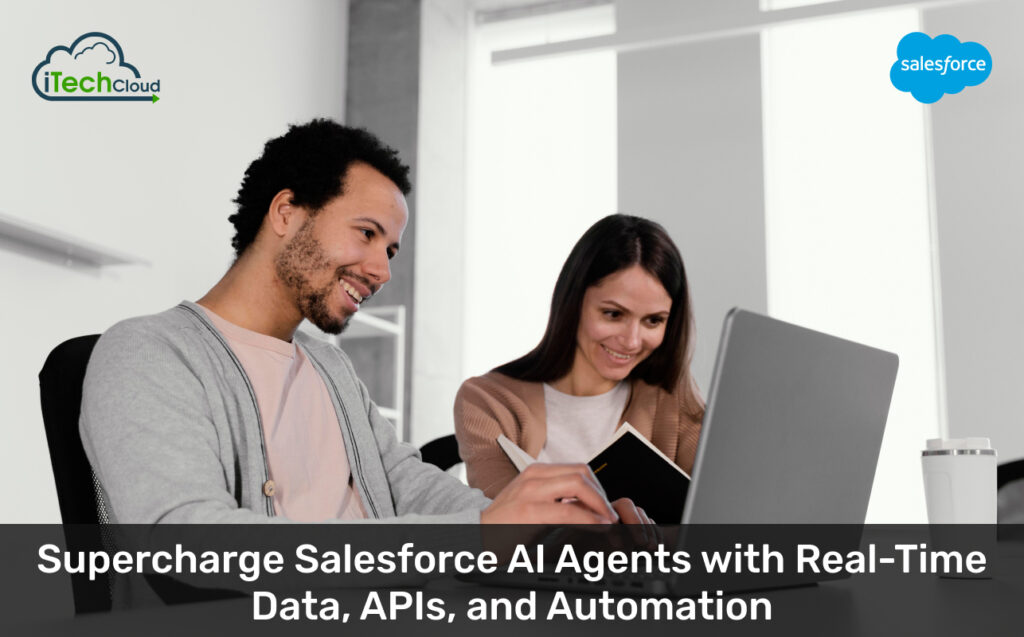Supercharge Salesforce AI Agents with Real-Time Data, APIs, and Automation

Introduction
Salesforce has long been a leader in customer relationship management (CRM), and with the integration of artificial intelligence (AI), its capabilities have expanded dramatically. AI-powered agents, such as Einstein Bots and predictive analytics tools, help businesses automate customer interactions, streamline workflows, and enhance decision-making. However, to maximize their potential, these AI agents must be supercharged with real-time data, APIs, and automation.
This blog explores how businesses can leverage these technologies to enhance Salesforce AI agents, ensuring they deliver smarter, faster, and more personalized customer experiences.
Table of Contents
1. The Power of AI Agents in Salesforce
Salesforce AI agents, powered by Einstein AI, are transforming how businesses interact with customers. These agents can:
- Automate customer support (e.g., chatbots resolving queries instantly).
- Predict customer behavior (e.g., recommending products based on past purchases).
- Optimize workflows (e.g., auto-assigning leads to the right sales reps).
However, their effectiveness depends on the quality and timeliness of data. Without real-time insights, AI agents may provide outdated or irrelevant responses.
2. The Role of Real-Time Data in Enhancing AI Agents
Why Real-Time Data Matters
AI agents rely on data to make decisions. If the data is stale, the responses will be too. Real-time data ensures AI agents have the latest information, enabling:
- Personalized customer interactions (e.g., offering discounts based on current browsing behavior).
- Proactive issue resolution (e.g., detecting and addressing service disruptions before customers complain).
- Dynamic decision-making (e.g., adjusting pricing or inventory recommendations instantly).
How to Integrate Real-Time Data into Salesforce AI
1. Salesforce Data Streams – Use Event Monitoring and Platform Events to capture live data.
2. Third-Party Data Integrations – Connect tools like Kafka, MuleSoft, or Snowflake for streaming analytics.
3. IoT Data Feeds – Incorporate sensor data (e.g., from smart devices) for real-time customer insights.
3. Leveraging APIs to Connect AI Agents with External Systems
APIs (Application Programming Interfaces) act as bridges between Salesforce AI and other business systems, unlocking new capabilities.
Key Use Cases for API-Driven AI Agents
- Payment Processing – Integrate with Stripe or PayPal to enable AI agents to process refunds or check transaction statuses.
- Inventory Management – Connect with ERP systems (SAP, Oracle) to provide real-time stock updates.
- CRM Enrichment – Use APIs from Clearbit or ZoomInfo to auto-update lead profiles.
Best Practices for API Integration
1. Use Salesforce Connect – For seamless external data access.
2. Leverage REST & SOAP APIs – For real-time data exchange.
3. Implement OAuth Security – To ensure secure API authentication.
4. Automating AI Agent Workflows for Efficiency
Automation ensures AI agents operate at peak efficiency, reducing manual intervention.
Key Automation Strategies
1. Trigger-Based Actions – Use Salesforce Flows to automate responses (e.g., sending follow-up emails after a chatbot interaction).
2. AI-Powered Routing – Automatically assign cases to the best-suited agent using Omni-Channel Routing.
3. Self-Learning Bots – Enable Einstein Bots to learn from past interactions and improve over time.
Examples of AI Automation in Salesforce
- Lead Scoring Automation – AI ranks leads based on engagement, ensuring sales teams focus on high-potential prospects.
- Automated Case Resolution – AI suggests knowledge articles or solutions before escalating to a human agent.
5. Combining AI, APIs, and Automation for Next-Level CRM
The true power of Salesforce AI agents emerges when real-time data, APIs, and automation work together.
Example: AI-Powered Customer Support
1. Real-Time Data – A customer chats with an Einstein Bot about an order issue.
2. API Integration – The bot fetches the latest order status via an eCommerce API.
3. Automation – If the issue is unresolved, the bot auto-creates a support ticket and assigns it to an agent.
Example: Smart Sales Assistants
1. Real-Time Data – AI detects a lead visiting a pricing page multiple times.
2. API Integration – It pulls the lead’s past interactions from Marketing Cloud.
3. Automation – The AI sends a personalized discount offer via email.
6. Challenges & Solutions in Supercharging AI Agents
Challenge 1: Data Latency
- Solution: Use real-time streaming (e.g., Salesforce Platform Events).
Challenge 2: API Rate Limits
- Solution: Implement caching mechanisms to reduce redundant API calls.
Challenge 3: AI Training Gaps
- Solution: Continuously feed AI models with updated datasets for accuracy.
7. Future Trends: Where AI-Powered Salesforce is Heading
1. Generative AI in CRM – AI agents drafting emails, reports, and even contracts.
2. Voice-Enabled AI Assistants – Integrating with Amazon Alexa & Google Assistant for hands-free CRM control.
3. Predictive Compliance – AI detecting regulatory risks before they occur.
My Takeaway: Salesforce AI Agents
Supercharging Salesforce AI agents with real-time data, APIs, and automation unlocks smarter, faster customer interactions. Real-time insights ensure up-to-date responses, APIs connect external systems for richer functionality, and automation streamlines workflows. Together, they transform AI from reactive assistants into proactive growth engines, boosting efficiency and personalization. Businesses embracing this integration will lead in customer experience and operational agility.

